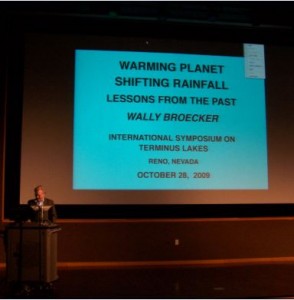
“We must prepare for a change toward dryness” said Wally Broecker in his keynote address Warming Planet, Shifting Rainfall, Lessons from the Past.
Broecker, from Lamont-Doherty Earth Observatory and well-known in the climate science field, was Tuesday’s keynote speaker at the International Symposium on Terminus Lakes. He first visited the western Great Basin in the early 1950s and did the first radiocarbon dating on ice-age lakes Bonneville and Lahontan, which at times were sixteen times the size of the present Great Basin lakes.

Sixteen times is huge—if you triple runoff and cut evaporation by 1/3, you dramatically change the climate but you still don’t even come close to the size of those prehistoric lakes. Now, thanks to human-induced changes, many of these lakes (including Mono Lake by volume) were reduced to half the size that they were in the 1880s.
In his talk, Broecker presented an inverse connection between the monsoon rains in China and wetness in the US Great Basin. He and Scott Stine and others looked at lakes at similar latitudes in the northern and southern hemispheres and found past fluctuations of similar magnitudes in sync in time—all seemingly connected with the strength of the monsoon.
The planetary hydrologic system has a rhythm. The world’s hydrologic cycle follows the Chinese monsoon pattern. When China is wet, the Great Basin is dry. When China is dry, the Great Basin is wet. A warmer world means a stronger monsoon and a drier Great Basin.
Broecker said this is a preliminary report—more study is needed at more lakes—but with a warmer world, we should expect a shift in rainfall, especially here in the Great Basin. He mentioned Scott Stine’s research on tree stumps found in the Walker River and Walker Lake (as well as Mono Lake) that revealed century-long medieval droughts.
He said we need to be prepared to respond to changes: “Maybe you should all move,” he quipped. And it behooves us to do something about rising CO2 levels: “there is a lot of talk, but little action.” It is a huge challenge. We need to halt our net emissions and capture and store carbon—a topic he writes about in his new book, Fixing Climate (read it at this link).
Coming Soon: Terminus Lakes Symposium Part 3—Researching our neighbor to the north—the first step in saving Walker Lake
